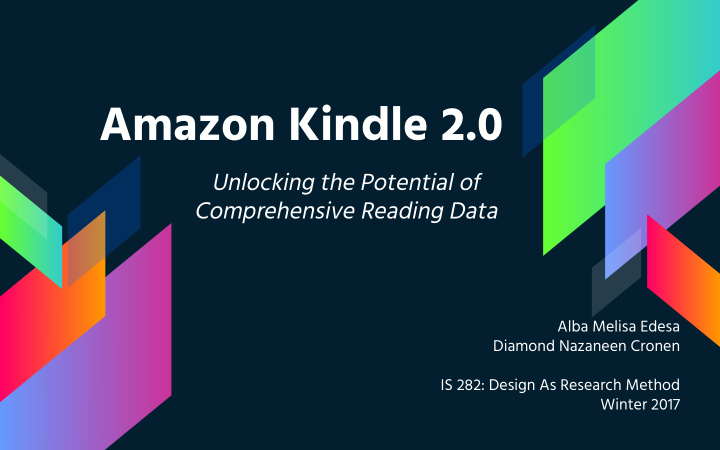



Amazon Kindle 2.0 Unlocking the Potential of Comprehensive Reading Data Alba Melisa Edesa Diamond Nazaneen Cronen IS 282: Design As Research Method Winter 2017
Agenda 1. Introduction 2. The Elevator Pitch 3. Kindle App Basics 4. New Data-Driven Features 5. The Data 6. User Experience
“A growing share of Americans are reading e-books on tablets and smartphones rather than dedicated e-readers, but print books remain much more popular than books in digital formats.” -Pew Research Center
What else could readers want?
2. The Elevator Pitch Our Proposal in a Nutshell
In 30 Seconds or Less... An improved Kindle app that captures a user’s reading data and stores this data on Amazon Cloud servers allows for the creation of comprehensive reading data sets. Users can access this data via reading profiles that are populated and updated in real time as they read.
3. Kindle App Basics What the Kindle Does Now
Annotation Features › Highlight › Note Social Media Features › Recommend Book › Share a Quote Reference Features › Translation › Dictionary › Wikipedia
Reading Speed Feedback › Reading speed calculated per book › Data stored locally on device ONLY
4. New Data-Driven Features Comprehensive Reading Data and User Reading Profiles
Capturing Reading Data Storing reading data captured from a Kindle device on Amazon Cloud servers would allow for . . . › Aggregated Reading Speed Data › Aggregated Annotation Data › Other data aggregations (i.e., Total Books Read, Total Pages Read) › The ability to generate data visualizations of trends over time
User Reading Profiles Captured Reading Data will be used to populate reading profiles that will allow users to . . . › Access visualizations of personal aggregated reading data over time › Access reading data per book › Integrate other social media platforms to share data among friends › Access Reader Data Analytic Reports (Authors)
COST EFFECTIVE! 5. The Data ➔ Collected by Kindle device. ➔ Stored on Amazon Servers. ➔ Accessed from Amazon Servers.
6. User Experience ➔ New features will be integrated into existing A A application following similar L L S S O O graphical design elements C C O O S S T T and task flows E E F F F F E E C C T T I I V V E E ! ! ➔ Will leverage existing information architecture of the application.
THANKS! Any questions? You can find us at: albaedesa@ucla.edu · dcronen@ucla.edu
Sources http://www.pewinternet.org/2016/09/01/book-reading-2016/pi _2016-09-01_book-reading_0-04/ https://www.amazon.com/gp/help/customer/display.html?no deId=201733740
Credits Special thanks to all the people who made and released these awesome resources for free: › Presentation template by SlidesCarnival › Photographs by Startupstockphotos
Recommend
More recommend